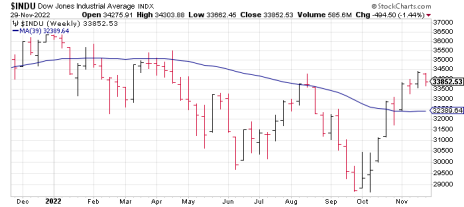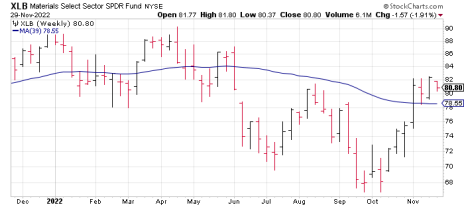Trend following is often dismissed by investors, yet its usefulness can’t be denied. The basic premise behind it is that tracking an established trend line (which tend to “stay in motion” according to Newton’s First Law) allows participants to simplify the stock and ETF selection process while benefiting from sometimes explosive moves in growth-oriented issues.
Historically, trends in the stock market tend to persist. Unlike cyclical assets like commodities and cryptocurrencies, stock trends can last for months or even years, making them ideally suited for investors who embrace a trend-following approach.
One of the best tools for following stock market trends is the 39-week moving average (MA). This particular tool was one of the favorite trend lines of Cabot’s late founder, Carlton Lutts, as well as legendary mutual fund trader and newsletter writer Dick Fabian. The 39-week line closely corresponds to the popular 200-day MA used by many traders today, but the former typically provides slightly more reliable signals when using a weekly timeframe.
[text_ad]
Describing the utility of the 39-week MA for trend investing, Lutts wrote:
“Using the trend principle, we can never be on the wrong side of the market’s long-term trend for very long. And once the new trend forces us onto the correct side of the market, the probabilities favor a continuation of the new market trend.”
Fabian, meanwhile, beat the market for many decades using the 39-week MA for timing mutual funds and the stock market. His system has proven to be consistently reliable for confirming when the broad market has established a major bottom going all the way back to 1929.
Fabian’s rule for fund timing is simple: He advocated buying an actively traded fund on a weekly close above a 39-week trend line (this rule also applies to ETFs). Additionally, his rule states that either the Dow Industrials or Dow Utilities should have also closed above their 39-week MA. His technique further advises selling when the fund’s weekly close is below the 39-week MA, and either the Industrials or Utilities have also closed under their 39-week lines.
For broad market timing, Fabian advised buying stocks whenever the Dow Industrials closes 2 percent above the lowest point of the market decline, the Dow Transports are 4 percent above the lowest point of the decline, and the Dow Utilities are 8 percent above the lowest point of the decline.
With that in mind, let’s evaluate the current market environment. According to the above-mentioned method, the stock market has registered a bottom since all three Dow averages are well above their yearly lows by the required percentages. Moreover, the Dow Industrial Average is above the 39-week MA as of the end of November.
Now let’s take a more specific look at an actively traded sector fund that has just recently closed above the 39-week trend line, signifying a bullish trend reversal. Basic materials stocks are a key outperformer in this category, as the chart of the Materials Select Sector SPDR ETF (XLB) attests.
While strength in the somber materials sector may not always be the best sign for the broader market, it has tended to be a good sign of long-term momentum for the sectors itself. As market statistician Jason Goepfert of SentimenTrader recently commented, “[Materials stocks] have rarely, if ever, declined in the 6-12 months following a resurgence of interest like they’ve enjoyed over the past couple of months.”
Materials sector stocks are just one way of taking advantage of the Lutts/Fabian trend-following approach involving the 39-week trend line. As the broad market recovery (presumably) expands, it will be important for trend-following investors to watch other major sectors for improving strength and profit opportunities. Using this reliable trend-tracking tool is an extremely useful—and easy—way to do this.
To learn more about technical analysis of stocks, download this free report. Or, if you’d rather trade alongside an expert momentum trader, consider a subscription to Cabot Top Ten Trader today!
[author_ad]



